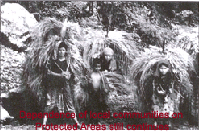Protected
Areas : The Changing Scenario
|
Natural
areas the world over have been protected through the ages for reasons ranging
from biological, religious, cultural and recreational. Today, protected areas
are also acknowledged as being one of the most effective means of conserving
biological diversity in situ.
In India, Emperor Ashoka, who
ruled in the 3rd century B.C., set up sanctuaries for wild animals. Indian
royalty and then the Moghuls also reserved areas, mainly for the purpose of
sport hunting. Game reserves were established during the British colonial period
too. There have also existed areas such as ‘sacred groves’ that have been
zealously protected for religious reasons by local communities. Legally, under
the Wildlife (Protection) Act 1972, India has three categories of protected
areas i.e. National Park, Wildlife Sanctuary and the Closed Area (a category
rarely used).
 Despite the fact that over the
years, areas have been protected for various reasons, most legal protected areas
are the result of the Government’s decision that certain areas of forest,
grassland, wetland or coastline are of value to the nation and should be
protected, most often at the cost of local communities. What planners seemed to
overlook was that in most countries, some communities have had a historical
dependence on resources found in the areas and that it was not possible to ‘close
off’ these areas without providing viable alternatives to the people.
Despite the fact that over the
years, areas have been protected for various reasons, most legal protected areas
are the result of the Government’s decision that certain areas of forest,
grassland, wetland or coastline are of value to the nation and should be
protected, most often at the cost of local communities. What planners seemed to
overlook was that in most countries, some communities have had a historical
dependence on resources found in the areas and that it was not possible to ‘close
off’ these areas without providing viable alternatives to the people.
Today, the realities being what
they are, it is no longer possible to ‘set aside’ areas for conservation nor
manage them as isolated units. Protected areas exist as islands in a sea of
humanity and this has to be recognised.
Protected areas, globally, are
today under a series of threats :
-
In
developing countries in particular, PAs (managed as they are) have
resulted in antagonising the local people, leading to conflicts, often
damaging the areas themselves.
-
PAs
are bearing the brunt of commercial pressures such as mining, felling etc.
-
The
alienation of traditional communities and the onslaught of urbanisation
are resulting in the loss of traditional knowledge as also the erosion of
traditional methods of conservation.
Perhaps, the biggest challenge
for every nation is how to maintain protected areas in the face of these
pressures. It is time for a new paradigm to manage protected areas that takes
into consideration economic realities, local concerns and also ensures that
protected areas can adapt to changes over the next several decades.
What then must be
done ?
-
Protected
Areas can no more be managed by one organisation/institution and there is a
need to develop new
partnerships in order
to manage these areas better. If local communities are acknowledged as the
stewards of these areas, then joining hands with them might be a more
efficient way of conservation. Relationships with the private commercial
sector also need to be strengthened.
-
Protected
areas must be viewed within an integrated landscape management framework and
a bio-regional
approach. Since
biodiveristy-rich regions now remain only as small pockets within a vast sea
of urbanisation, corridors, connecting one such pocket to another, need to
be thought of. Conservation and sustainable development need to be viewed as
integrated parts of the whole picture. Existing biosphere reserves could be
used as models for promoting this concept.
-
With
new partnerships, management
regimes also
have to be flexible
and accept as members,
all the relevant stakeholders in the protected areas. Local community
members, even though they may not have tenure rights, should become an
important part of the planning and management of the area.
-
Cultural
diversity is closely linked to biological diversity. Different cultures,
particularly those living in biodiversity-rich regions, have accumulated
over millions of years a wealth of knowledge about their surroundings, which
is invaluable. Only a fraction of this is captured by professional
biologists. Conserving
cultural diversity is,
thus, essential for preserving this knowledge.
At the close of the 20th century,
the world faces a population-explosion culminating in over-consumption and other
human-induced changes such as global warming. In such a world, protected areas
are absolutely essential. However, it must be kept in mind that management of
these areas must be flexible, taking into consideration the changing
environmental, social, economic and political conditions. q
Seema
Bhatt

 Despite the fact that over the
years, areas have been protected for various reasons, most legal protected areas
are the result of the Government’s decision that certain areas of forest,
grassland, wetland or coastline are of value to the nation and should be
protected, most often at the cost of local communities. What planners seemed to
overlook was that in most countries, some communities have had a historical
dependence on resources found in the areas and that it was not possible to ‘close
off’ these areas without providing viable alternatives to the people.
Despite the fact that over the
years, areas have been protected for various reasons, most legal protected areas
are the result of the Government’s decision that certain areas of forest,
grassland, wetland or coastline are of value to the nation and should be
protected, most often at the cost of local communities. What planners seemed to
overlook was that in most countries, some communities have had a historical
dependence on resources found in the areas and that it was not possible to ‘close
off’ these areas without providing viable alternatives to the people.